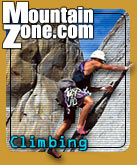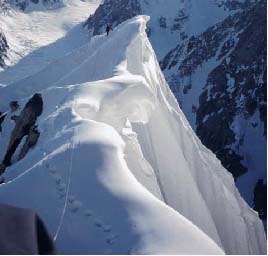
|
Mind Over Matter For a pair of Kiwis, Alaskan mountaineering pushes them to the edge... February 5, 2004
Pages »1 2
I was an Alaskan neophyte, full of hope, expectation and ignorance. I had begun the trip hopeful that Alaskan mountaineering was going to be similar to the New Zealand version with which I was familiar. I even expected that I my home-grown skills would be easily adapted to what was to be found in this northern neighbourhood. However, I was fast discovering that I was woefully ignorant about the things that were not the same. Pat had warned me that climbing in the Alaska Range involves a hefty amount of suffering. I'd blithely assumed that suffering was all physical; you know, burning calves, a bent back, hot aches in the hands-the usual stuff that goes hand-in-hand with all decent mountaineering. It soon became clear that the biggest difference between New Zealand and away lay in that grey area of uncertainty and decision making. It was the realm of the mind, not the body, where the greatest struggle took place. After 10 days in the hills Pat and I had suffered through two attempts on peaks in the Tokositna Glacier. The first sufferance achieved a first ascent of the North Face of Pk 11,520. Our next suffering brought a frustrating rebuff of the South Face of Kahiltna Queen. For me, each climb had been characterized by unexpected developments. Our line on Pk 11,520 was always going to be a risky undertaking. It blasts up a 50-degree avalanche couloir that extended almost 1,000 metres before linking up with a fan-like arrangement of feeder gullies. "Fair enough", we'd reasoned, "we'll wait for a 24 hour spell of good weather, and grind it out." After a week of waiting the blue skies duly arrived. Fifteen hours of steel-hard ice later we were butting up against the summit cornice. A sneaky mist had been hanging around for the past hour, but no high cloud was apparent. Simultaneously the cloud thickened, the wind picked up, snowfall filled the sky, and the feeder gullies began emptying their contents into the large intestine below that formed our only escape route. We were flummoxed at this unexpected transition from fine weather to storm. The weather signs that I was used to reading in New Zealand had not materialized. As a consequence our situation was instantly transformed from a controlled physical ordeal to that of a mentally stressful fight for survival. We arrived back at our glacier advance-bivvi camp feeling emotionally wrought and lucky to be alive. Thirty-six hours later we skied to the foot of Kahiltna Queen and picked our way upward through the awkward approach pitches to gain a spacious left-leaning couloir that promised easy delivery to the top third of the face. I had a mental picture based on my New Zealand climbing of what this would be like: straight-forward terrain that Pat and I could mostly move together on, with our security guaranteed by a combination of regular running belays and reasonable crampons and tool placements.
To our surprise the snow conditions were exactly the opposite of what we had experienced on the earlier climb. Knee-to-thigh wallowing through a crust that overlaid a sugar-like base left us exhausted and increasingly scared after each pitch. The granite walls of the couloir gave only false hints of cracks, despite close inspection and mole-like digging beneath the snow-cover. Without fixed belays we risked being swept off by occasional spindrift avalanches that curled down from the overhanging flanking wall to our right. And the weather? It looked somber, but did that therefore mean it was about to change? Without the comfort of confidence we couldn't push it any further. We descended back to our bivvy tent, packed our sleds, and set off hauling back to base camp. The weather deteriorated at once. I had my GPS ready for such an eventuality, but the steep-sided valley prevented satellite recognition. It seemed too much of an effort to hunt out a compass in the driving snow, so we flogged on into the white-out. But now what's this? Hummocks of avalanche debris that surely couldn't be on our side of the valley? In the blizzard we had strayed hundreds of metres and 90 degrees off-course, ending up beneath a large set of ice-cliffs. When something's not right, it's wrong (Bob Dylan), so we got out of there quick-smart. Twenty-four hours later the sky was blue, there was no wind, and Pat and I were looking with bemusement at our struggles in the East Tokositna from the passenger-seats of a Beaver on our way to the Kahiltna Glacier.
The Park Ranger weather forecast was boding doom and gloom for the coming days. Much interest centered around the large telescope that was zeroed in on the imposing high North Face of Mt Hunter where an unusual battle of style was taking place on the Mugs-Aubrey Moonflower Buttress route. Two very experienced USA-based teams were attempting the route using the established big-wall tactic of hauling the majority of their equipment up the 4,000 feet of ice runnels that lead to the top of this fantastic face. English climbers Richard Cross and John Bracey were employing the "packs on backs" strategy, and had begun climbing 8 pitches after the above teams. The speedy duo raced past the Americans and on to the first of their two bivouacs. The disillusioned Yankee teams, over-awed by the audacity of the newcomers as well as by the threatening sky overhead, abseiled off the route. On the neighbouring Backes-Twight Deprivation route the well-known American climbers Kelly Cordes and Johnny Copp set off for a risky slight-weight no-bivvy attempt.
Page 2 »
|
||||||||||||||||

